|
Tribal Menace
design by Chris Ostlind
Length Overall |
22’ 6” |
Length Waterline |
22’ 1” |
Beam Overall (main hull) |
38” |
Beam Waterline (main hull) |
23” |
Beam Overall |
17’ 4” |
Draft (board up) |
10” |
Draft (board down) |
42” |
Sail Area |
170 sq. ft. |
Displacement |
1100 lbs. |
Back in April, Chuck published a set of illustrations for a design study that was proposed for competition in the Watertribe events… specifically, the Everglades Challenge.
I have been following the Watertribe, Everglades Challenge, events with a lot of enthusiasm since they were first announced. Because I live in Salt Lake City, the costs associated with traveling to Tampa, Florida for the start, along with the design and build of a competitive boat, kept me from participating. What I could do, however, was design a fast, Class 4 boat for the event and dream of the day when I could drive across the country to compete with a boat of my own design.
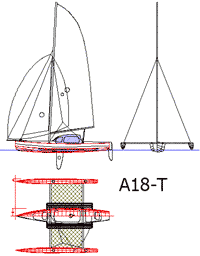 The first boat off the drawing board was the previously published A18, canoe/trimaran. The first boat off the drawing board was the previously published A18, canoe/trimaran.
After I got that boat underway in the shop, I began looking forward to design a really light boat for a crew of two that could carry a decent sail size when the wind came up. This new double would also need to be human powered for the inevitable sections of the course where there would be no wind at all. Additionally, it would have to be easily de-rigged for transport as well as confining locations on the Watertribe event that would restrict especially wide boats.
The boat had to be able to be reasonably sized to handle the potentially large conditions that can be present in the Gulf. It would also not be so pre-disposed for those conditions that it would then become over weight or too susceptible to weather cocking when being propelled by human power alone. I felt that the limited duration of the event allowed for a more exposed craft in which the crew could decently achieve some modest measure of adventure style comfort while still banging their way around the course.
To be sure, these types of boats are going to expose the crew to the elements. It should be possible to snatch a few minutes (or hours) of less exposed comfort within the hull to provide for a reasonably recharged crew member when it is their turn to take the watch, but it’s no Marriott with a shower by any means. Geez, it’s not even a lo-dough motel with questionable plumbing.
After distilling these design types for the last couple of years, I have arrived at a boat that I feel would be not only a winning, crewed entry as a Class 4, Watertribe boat, but would also make for a wonderful platform for minimalist, long distance coastal adventure cruising.
The result of all this fiddling is the 22.5’ Tribal Menace (TM).
The Boat
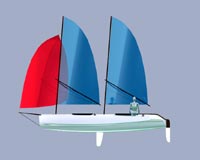 (click images to enlarge)
(click images to enlarge) |
This boat emerged from a series of drawings I did regarding a 21’ beach trimaran. I will submit an additional article on the new boat in the very near future, but this article is about the Tribal Menace the just magically evolved from the previous design.
Originally, the TM was designed to be constructed in foam core sandwich with S-glass outer skins and Kevlar inner laminates in epoxy for durability, low weight, and maintenance ease. The maintenance issue was one of my main concerns as boats of this type are going to be subjected to regular hard use and the ding fixing process could be a decent part of the regular preparation for each and every journey.
Subsequent designs have been developed to allow the boat to be built from marine ply in a multichine design form for stitch and glue construction. This allows the eventual builder to have a choice as to how they wanted the boat of their adventure dreams, within the budget limitations of their choosing.
The specification data for the design is carried in a separate box within this article so feel free to examine the data to get an overall idea as to how the boat measures-up.
I estimate that this boat can be built at just over 400 lbs. dry weight if done in foam sandwich. The plywood version should show-up at something over 500 if the builder is serious about use of epoxy and saving weight. At these weights, there is little in the way of interior finish work, save for very lightly sanded epoxy joints. One might call it race boat interior quality where no extra coats of epoxy are applied to smooth the weave.
Exterior finish is taken to a smoothly floated finish in which the boat is painted if foam built and if done in plywood, either left bright and varnished or also painted. Premium Okuome is necessary to get the really light weight in the ply boat, but it could also be built, with a slight weight penalty, in less expensive Hydrotek or Aquatek ply to keep the budget more under control.
The Rigs
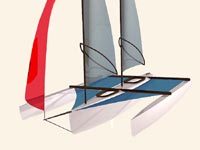 The twin, wishbone sprit boomed rigs are built on 18’ carbon windsurfer masts with epoxied, 2’ mast base extensions to take them out to a full 20’. The masts are self-supporting through the deck with a 28” bury for enormous strength. The sprit-rigged sails are hoisted in sail tracks that are glued to the carbon sticks with Sikaflex. This allows the sails to be easily reefed while retaining the lightweight philosophy of this boat. The wishbone sprit booms can be either a single or dual configuration depending on whether the owner wants the projected weight savings of the single boom or the tough durability of the dual bone setup. The twin, wishbone sprit boomed rigs are built on 18’ carbon windsurfer masts with epoxied, 2’ mast base extensions to take them out to a full 20’. The masts are self-supporting through the deck with a 28” bury for enormous strength. The sprit-rigged sails are hoisted in sail tracks that are glued to the carbon sticks with Sikaflex. This allows the sails to be easily reefed while retaining the lightweight philosophy of this boat. The wishbone sprit booms can be either a single or dual configuration depending on whether the owner wants the projected weight savings of the single boom or the tough durability of the dual bone setup.
I chose this rig setup for a number of reasons. The mast and sail combinations are very light in weight for the power they can deliver. The aspect ratio of the sail is low and decently powerful in a wide variety of conditions. The sails are easily reefed, either singly or in concert. The center of effort for the entire rig is kept low, reducing righting forces. This keeps the volume needs of the amas low as well, further reducing overall boat weight. If the boat is caught way out in an exposed situation in a bad squall, the forward mast can be dropped and secured, a drogue or parachute anchor thrown off a bow bridle and, with a seriously reefed aft sail, the boat can ride-out the squall in safety.
Rig Enhancements
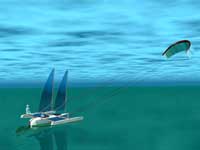 The illustrations show the boat with a carbon bowsprit while flying an asymmetrical chute. I’m not entirely sold on this idea as a spinnaker of this type can actually drive the bows down while sailing unless the crew is well aft and outboard on the tramp/ama. I’ve spent a lot of time sailing spinnaker equipped beach cats and while the chute can deliver eye-popping speeds off the wind, it is also a huge handful that requires a lot of attention. If the spinnaker option is chosen, the forward mast will need to be stayed in a conventional fashion to safely handle the extra loads. The illustrations show the boat with a carbon bowsprit while flying an asymmetrical chute. I’m not entirely sold on this idea as a spinnaker of this type can actually drive the bows down while sailing unless the crew is well aft and outboard on the tramp/ama. I’ve spent a lot of time sailing spinnaker equipped beach cats and while the chute can deliver eye-popping speeds off the wind, it is also a huge handful that requires a lot of attention. If the spinnaker option is chosen, the forward mast will need to be stayed in a conventional fashion to safely handle the extra loads.
Perhaps a more elegant solution would be to fly a traction kite from the forward beam and get more power from the same sail area with none of the downward tendencies. In fact, a kite will create lifting tendencies, which will reduce the wetted areas of the hulls and lead to a faster boat.
Foils
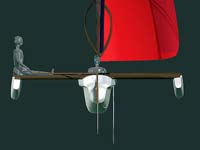 There is a single, deep rudder on the vaka to keep weight down, along with providing solid steering even when the main hull starts to lift a bit. The rudder is a bungee-loaded rig that can ride-up over any obstacles and allows for beaching without damage to the boat. The foil section is designed to provide control through a wide latitude of angles of attack without stalling. A surface dam on the rudder will be suggested to keep the blade from sucking air down its length during fast sailing, causing a stalled foil. There is a single, deep rudder on the vaka to keep weight down, along with providing solid steering even when the main hull starts to lift a bit. The rudder is a bungee-loaded rig that can ride-up over any obstacles and allows for beaching without damage to the boat. The foil section is designed to provide control through a wide latitude of angles of attack without stalling. A surface dam on the rudder will be suggested to keep the blade from sucking air down its length during fast sailing, causing a stalled foil.
The rudder can be controlled from outside the hull via standard, beach cat style, tiller extension, or it can be controlled from inside the hull at the aft cockpit location with typical, foot pedal fixtures. This means that the boat can be sailed from inside the hull in light-to-moderate winds, which will reduce exposure to the conditions and extend the comfort range of the crew.
I don’t anticipate that this boat will be sailed hard in conditions which would lift the main hull, unless the crew are very experienced multihull sailors and can read the wind and the performance of the boat critically. More likely, it will be a fast cruising mode that can be kept-up for long periods of time, especially in ideal conditions.
The keel functions are handled by a rotating leeboard that tucks up under the hull deck flare when not in the water. The leeboard is of a moderate aspect ratio to provide lift, resistance and keep the draft to a minimum for the shallow waters of the Florida Coast. It’s from a foil section that optimizes efficiency while resisting stall at low speeds.
Like any foil, the trade-offs of design are managed by taking a long look at the principal areas of performance and then forming a foil decision that keeps the boat running well throughout its intended use curve. The TM is capable of some pretty decent speeds in strong winds on the water and could utilize a foil section that is optimized for that potential. The drawback is that for the boat to demonstrate good qualities while in light air, especially upwind, it needs to have a different foil in order to work acceptably in all conditions in which it will operate. Foils that have design limitations at high speeds do not typically work well at low speeds. The reverse is also true for low speed foils.
I would rather pay a small, performance penalty at the high end, than have a boat that is just dreadfully aggravating when the wind is light and you are struggling to make headway. The result is a foil that works well in a wide latitude of applications, but is not dialed-in for any specific boat speed use. Lightweight hulls and performance potential needs to be balanced by the realities of a large wind and speed variability.
Design Utility
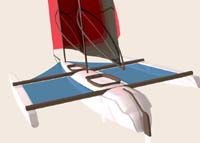 The main hull is designed to provide a fast, controlled sailing experience while presenting the slimmest forward section for efficiency. The slim sections are balanced with the need to give the crew some measure of comfort while on the water. Specifically, the off-watch crew gets to lie down in the hull with a degree of comfort and not have to feel as if they’ve been squeezed into a human sized gelatin capsule for their needed sleep. The main hull is designed to provide a fast, controlled sailing experience while presenting the slimmest forward section for efficiency. The slim sections are balanced with the need to give the crew some measure of comfort while on the water. Specifically, the off-watch crew gets to lie down in the hull with a degree of comfort and not have to feel as if they’ve been squeezed into a human sized gelatin capsule for their needed sleep.
It’s a fine line trying to develop a hull that is at once fast under sail and paddle and also provides enough room for the human body without severe claustrophobia. The TM addresses that issue nicely.
There are two, cockpit style openings in the deck; one for each of the crew. The two areas are separated internally by a structural bulkhead. There are also fixed bulkheads at each end of the hull for flotation compartments. These flotation bulkheads have watertight hatches for access and stowage of light gear.
Each cockpit can be equipped with a folding dodger at the leading edge and extending about midway back on the cockpit rim to keep out wave action and spray.
Seating is key for a boat of this type as there could be long periods where the Mirage systems are employed and crappy seats can quickly push the experience into the “Never Again” category. The TM is equipped with plastic tractor-style seating with folding backs. It is intended that the crew will equip the seats with the Crazy Creek folding pad setups that have the mounting straps under the hard shell seat for secure seating.
The seats are hung from light guage, stainless, Ronstan sail tracks under the gunnels and can be adjusted up, down, forward and aft as well as full control of the pitch. This allows for infinite comfort adjustments underway and gives the crew total control of their seating positions to break long spells in one position. If the boat is taken to shore during a casual coastal cruise, the foam seats are removed to serve as camp chairs and/or sleeping pads. Another piece of equipment that serves two and three duties; saving weight, adding utility and giving increased pleasure to the whole expedition.
Amas
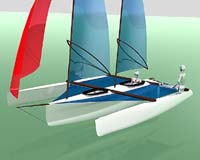 The amas are super slim to allow for the least resistance, to be as light as possible and to still provide for a minimum of righting moment. If you were to look at the hulls of a beach cat that carries the same sail area, you would find that they are nearly twice the width of these hulls. This reduced frontal area gives huge advantages to fast multihulls through reduced drag numbers. The amas are super slim to allow for the least resistance, to be as light as possible and to still provide for a minimum of righting moment. If you were to look at the hulls of a beach cat that carries the same sail area, you would find that they are nearly twice the width of these hulls. This reduced frontal area gives huge advantages to fast multihulls through reduced drag numbers.
The ama flotation is heavily biased towards the bow to further resist pitch poling while reaching and running. Their unique form presents only as much wetted surface to the water as is needed while under sail. The decks are canted 6 degrees to the inside to present the smallest wetted profile to the water as the ama is pressed. This reduces drag and makes for a faster boat.
Design Philosophy
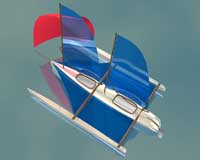 The TM is meant to be an actively sailed boat; one in which the crew is designed as part of the righting moment package from the beginning. This means that if the wind comes up while under sail, that both crew members could be potentially obligated to get out on the tramps to resist the power being generated, or sheet out and reduce sail area so that the boat can keep blasting down the course. The TM is meant to be an actively sailed boat; one in which the crew is designed as part of the righting moment package from the beginning. This means that if the wind comes up while under sail, that both crew members could be potentially obligated to get out on the tramps to resist the power being generated, or sheet out and reduce sail area so that the boat can keep blasting down the course.
Like all designs, this boat has to decide for which master it will dance. Some boats dance for stable, predictable movement through their environment. They provide consistent pace and allow for reasonably predictable rest and drive cycles.
Others take the tempo up a notch and find their groove at a faster pace. These boats, because of their enhanced speed potential when the conditions are favorable, sometimes have to toss previous plans for resting cycles. This is where the designs for a two-man crew have their biggest advantage. They can power right through rest stops by providing the crew a reasonably comfortable place to rest while the boat continues. The caveat is that to have the best part of this advantage, the conditions need to be favorable. Without these conditions, the boat is in among the rest of the fleet and will have to rely on human power and slick sailing skills in light air.
There have been a wide variety of boat types and configurations in each of the previous EC’s. With this design, I have chosen to give the boat a superior sailing performance function that pretty much obligates the crew to be slightly better than average sailors. The payback for that skill, in the right conditions, will be a boat that can cover huge amounts of water in a short amount of time.
This is not a boat where you can button-up and the boat will sail itself in stronger conditions. It is possible to reef and tune each sail to provide for optimal control and the schooner rig is ideal for that application. Still, the driver on watch will need to be the master of his domain and the boat will require that he pay attention to avoid being dumped.
The reward will be watching the competition recede over the horizon as you press-on down the EC course.
The narrow bridge filter of the EC is addressed in the same manner as my other boat, the A18. Each aka is sectioned into three pieces. This allows the center element to be removed so that the amas can be re-attached closer to the main hull to allow the boat to navigate the smaller bridge opening. The self-supported masts are lifted and stowed on the shortened beams and the boat goes under the bridge. Once on the other side, the order is reversed and the boat is quickly back to its original form, ready to move on.
Human Power
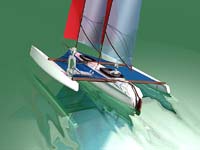 Human powered propulsion is handled by one of two approaches. Principal drive is via two, Mirage pedal units, one in each cockpit section. I previously published a full tutorial on the design and construction of the Mirage drive trunk. Human powered propulsion is handled by one of two approaches. Principal drive is via two, Mirage pedal units, one in each cockpit section. I previously published a full tutorial on the design and construction of the Mirage drive trunk.
There is a main deck in the boat that is slightly above the water line. This means that each of the Mirage units, when installed, sits neatly in the designed trunk and only the pedal levers are seen above the deck opening. The crewmember sits on a folding, Crazy Creek style, foam chair and comfortably strokes the Mirage down the course. When the Mirage is not being used, a watertight plug fits into the trunk, keeping the interior dry.
Either crew can provide propulsion in this manner or they can switch off to get some rest while the other continues.
The Mirage drive, to be really effective, needs about 14” of water under the hull. For truly thin water, that also requires a good degree of steering control, the crew simply pushes the Mirage blades up against the hull and they switch to stowed paddles for continued mobility.
Really thin water applications are not this boat’s forte. The TM really belongs out in deeper water where its attributes can shine.
So, there it is, The Tribal Menace. A multihull, adventure cruiser with enhanced coastal adventure cruising capabilities that make it the perfect crewed boat for locations such as The Keys or Belize. It can be a minimalist Mother Ship for paddled, waterway adventures or a stand-alone boat. It’s easily trailered with its lightweight and it can be assembled in under 30 minutes by reasonably familiar crew.
Write to me directly at: Chris@Wedgesail.com if you have any comments, constructive criticisms or are just curios about the deisgn.
Chris Ostlind
|

